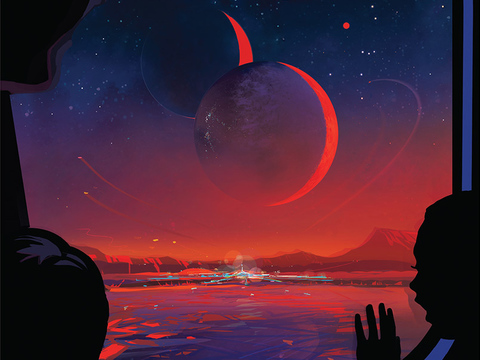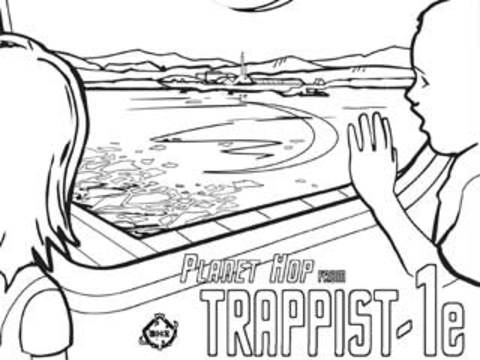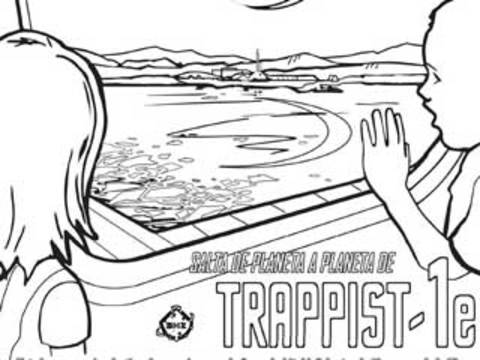Terrestrial planets (Earth sized and smaller) are rocky worlds, composed of rock, silicate, water and/or carbon. To determine if some of these worlds have atmospheres, oceans or other signs of habitability, it takes more investigation. Larger terrestrial exoplanets (those at least twice as massive as Earth) are classified as super-Earths.
Get to know some terrestrial planetsGet to know some terrestrial planets
TRAPPIST-1 e
TRAPPIST-1 d
In general, terrestrial planets have a bulk composition that is dominated by rock or iron, and a solid or liquid surface. These faraway worlds may have gaseous atmospheres, but that’s not a defining feature.
We've found rocky planets in Earth's size range, at the right distance from their parent stars to harbor liquid water (this is known as the habitable zone). While these characteristics don't guarantee a habitable world – we can't quite tell yet if these planets really do possess atmospheres or oceans – they can help point us in the right direction.
Key factsFuture space telescopes will be able to analyze the light from some of these planets, searching for water or a mixture of gases that resembles our own atmosphere. We will gain a better understanding of temperatures on the surface. As we continue checking off items on the habitability list, we'll draw closer and closer to finding a world bearing recognizable signs of life.
Seven terrestrial worlds of TRAPPIST-1Seven terrestrial worlds of TRAPPIST-1
In 2017, NASA announced the discovery of the most Earth-sized planets found in the habitable zone of a single star, called TRAPPIST-1. This system of seven rocky worlds – all of them with the potential for water on their surface – is an exciting discovery in the search for life on other worlds. Future study of this unique planetary system could reveal conditions suitable for life.
In February 2018, a closer look at the seven planets suggested that some could harbor far more water than the oceans of Earth, in the form of atmospheric water vapor for the planets closest to their star, liquid water for others, and ice for those farthest away. That research pinned down the density of each planet more precisely, making TRAPPIST-1 the most thoroughly known planetary system apart from our own.
It’s impossible to know exactly how each planet looks, because they are so far away and so faint compared to their host star. In our own solar system, the Moon and Mars have nearly the same density, yet their surfaces appear entirely different.
Based on available data, here are scientists' best guesses about the appearances of the planets:
TRAPPIST-1b, the innermost planet, is likely to have a rocky core, surrounded by an atmosphere much thicker than Earth's. TRAPPIST-1c also likely has a rocky interior, but with a thinner atmosphere than planet b. TRAPPIST-1d is the lightest of the planets – about 30 percent the mass of Earth. Scientists are uncertain whether it has a large atmosphere, an ocean or an ice layer – all three of these would give the planet an "envelope" of volatile substances, which would make sense for a planet of its density (less than half that of Earth).
Scientists were surprised that TRAPPIST-1e is the only planet in the system slightly denser than Earth, suggesting it may have a denser iron core than our home planet. Like TRAPPIST-1c, it does not necessarily have a thick atmosphere, ocean or ice layer – making these two planets distinct in the system. It is mysterious why TRAPPIST-1e has a much rockier composition than the rest of the planets. In terms of size, density and the amount of radiation it receives from its star, this is the most similar planet to Earth.
TRAPPIST-1f, g and h are far enough from the host star that any water they might possess could be frozen as ice across these surfaces. If they have thin atmospheres, they would be unlikely to contain the heavy molecules of Earth, such as carbon dioxide.
How many terrestrial planets are out there?How many terrestrial planets are out there?
The more we study, the more our understanding can change. One analysis of discoveries by NASA’s Kepler Space Telescope indicated that 20 to 50 percent of the stars in the sky are likely to have small, potentially rocky planets in their habitable zones. Newer data showed that the number is likely smaller – possibly between 2 and 12.
At first glance, that might seem disappointing: fewer rocky, potentially habitable worlds among the thousands of exoplanets found so far. But that doesn't change one of the most astonishing conclusions after more than 20 years of observation: Planets in the habitable zone are common.
Much more data are needed, including a better understanding of how a planet's size relates to its composition.
"We're still trying to figure out how big a planet can be and still be rocky," said Jessie Dotson, an astrophysicist at NASA's Ames Research Center in California's Silicon Valley. She is also the project scientist for Kepler's extended mission, known as K2. The spacecraft was retired in 2018, but discoveries are still being made using its data.
According to research released in October 2020, about half the stars similar in temperature to our Sun could have a rocky planet capable of supporting liquid water on its surface.
Our galaxy holds an estimated 300 million of these potentially habitable worlds, based on results in a study using Kepler data. Some of these exoplanets could even be our interstellar neighbors, with four potentially within 30 light-years of our Sun and the closest likely to be about 20 light-years from us.
This research helps us understand the potential for these planets to have the elements to support life. This is an essential part of astrobiology, the study of life’s origins and future in our universe. "Kepler already told us there were billions of planets, but now we know a good chunk of those planets might be rocky and habitable," said the lead author Steve Bryson, a researcher at NASA's Ames Research Center in California's Silicon Valley.
A strange gap in planet sizesA strange gap in planet sizes
Scientists have noted what seems to be a strange gap in planet sizes. It’s been dubbed the Fulton gap, after Benjamin Fulton, lead author on a paper describing it. The Kepler data show that planets of a certain size-range– those between 1.5 and 2 times the size of Earth – are rare. It’s possible that this gap represents a critical divide in planet formation: Planets that reach the larger end of the radius gap quickly attract a thick atmosphere of hydrogen and helium gas and balloon up into gaseous planets, while planets smaller than the gap are not large enough to hold such an atmosphere and remain primarily rocky. On the other hand, the smaller planets that orbit close to their stars could be the cores of Neptune-like worlds that had their atmospheres stripped away.
Explaining the Fulton gap will require a far better understanding of how solar systems form.
Explore the planet types: Gas Giant, Neptune-like, Super-Earth and Terrestrial
Or move on to the building blocks of galaxies: stars!










